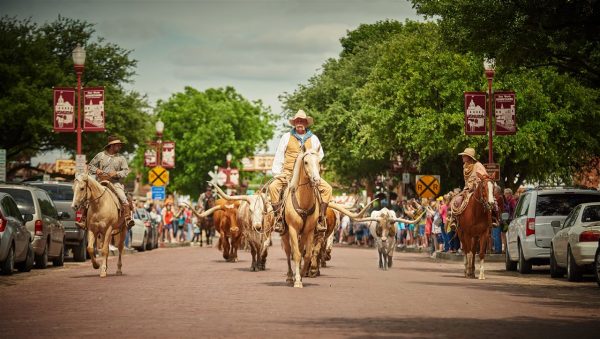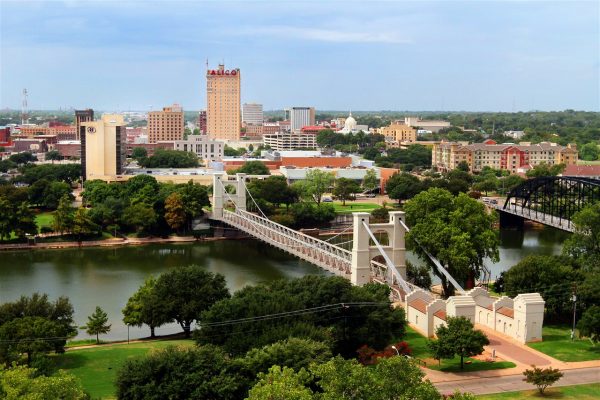 This year, 2017, marks the Chisholm Trail’s 150th anniversary. The Chisholm Trail is the greatest migration of livestock in world history that relocated cattle from South Texas through Oklahoma all the way to Abilene, Kansas. The first herd to make the journey using the Chisholm Trail set off in 1867 and continued until 1885, relocating more than 5 million cattle and a million mustangs.
This year, 2017, marks the Chisholm Trail’s 150th anniversary. The Chisholm Trail is the greatest migration of livestock in world history that relocated cattle from South Texas through Oklahoma all the way to Abilene, Kansas. The first herd to make the journey using the Chisholm Trail set off in 1867 and continued until 1885, relocating more than 5 million cattle and a million mustangs.
Take a look back into the Texas cowboy way of life by visiting the Texas towns and countless museums that continue to pay homage to the trail and the cattle industry’s history. You can explore the rich Texas history of ranch hands, cowboys and cattle by planning a trip to any one of these towns or all six.
Kingsville
Sitting on 825,000 acres in South Texas, an area larger than Rhode Island, the King Ranch established a “cow camp” and quickly became one of the most influential ranches in the world. Today, the King Ranch is a National Historic Landmark and offers several daily tour options: from the history of the ranch where you’ll see the historic Santa Gertrudis Creek, where Captain King first camped in 1852, along with the grand home built in 1912 by Captain King’s widow, Henrietta — to nature tours. A surprise to many is the fact the ranch is home to such a diverse ecosystem of plants and animals. In fact, famed conservationist Aldo Leopold called King Ranch “one of the best jobs of wildlife restoration on the continent” and it is now home to more than 363 species of birds, including the largest known population of ferruginous pygmy-owls in the U.S.
Yoakum
Like many towns that benefited from those traveling the Chisholm Trail, Yoakum did not sit on the trail itself, but is located about an hour from San Antonio. Due to its proximity to this population center, it quickly became used as a gathering ground for cattle to be driven up the Chisholm Trail and is considered by many to be the official starting place of the trail. With the introduction of the railroad, the trail became defunct so this inventive town found new ways to prosper beyond the cattle industry by encouraging its residents to grow tomatoes that could be easily shipped on the rail lines.
San Antonio
San Antonio became a gathering location for many herders starting their long journey. Trail drives were extremely important to the local economy. Now both the Witte Museum and the Buckhorn Saloon and Museum provide artifacts and exhibits that give visitors an idea of the beginnings of Texas cowboy life. While the Battle of the Alamo was long over by the time of the Chisholm Trail, history buffs can’t miss this incredible landmark while in town, along with the four other Spanish colonial missions, which were named a UNESCO World Heritage site in 2015.
Lockhart
Just 70 miles northeast of San Antonio, Lockhart was where two herding routes converged and on some days, 5,000 to 6,000 heads of cattle passed through this outpost. Today, on the second weekend of June, Lockhart celebrates the Chisholm Trail by hosting the Chisholm Trail Roundup, a four-day festival, featuring a chili cook-off, rodeo and even a cowboy breakfast around a chuck wagon on the courthouse square. You can also celebrate the trail’s spirit year-round at Chisholm Trail Bar-B-Que, which has been serving slow-cooked meats from real pits using post oak wood since 1978.
Waco
Continuing northward, cattle herds crossed the Brazos River in Waco on their way to Kansas. In 1870, the newly completed Waco Suspension Bridge, a National Historic Landmark created by the same architect behind the Brooklyn Bridge, provided a convenient, albeit costly, means for cattlemen to move herds across the Brazos. A sculpture near the Waco Suspension Bridge still commemorates the famous Chisholm Trail and captures the diversity of trail riders. These days, Waco provides visitors with an incredible range of activities, from checking out Ice Age–era fossils at the Waco Mammoth National Monument to uncovering delightful home and garden goods at Magnolia Market.
Fort Worth
Fort Worth, for many traveling the Chisholm Trail, was the last main stop to rest and refresh supplies. The city quickly became known as “Cowtown.” Today, the Fort Worth Stockyards transports visitors back in time when watching the Fort Worth Herd, the world’s only twice-daily cattle drive, which takes place from 11:30 a.m. to 4 p.m. every day in the stockyards. This area also features several restaurants and shops, along with the Stockyards Museum.
Explore historic Texas towns and make history come alive in celebration of Chisholm Trail’s 150th anniversary across the Lone Star State. For more information about travel experiences in Texas, visit www.TravelTexas.com and find us on Facebook, Twitter and Instagram.


